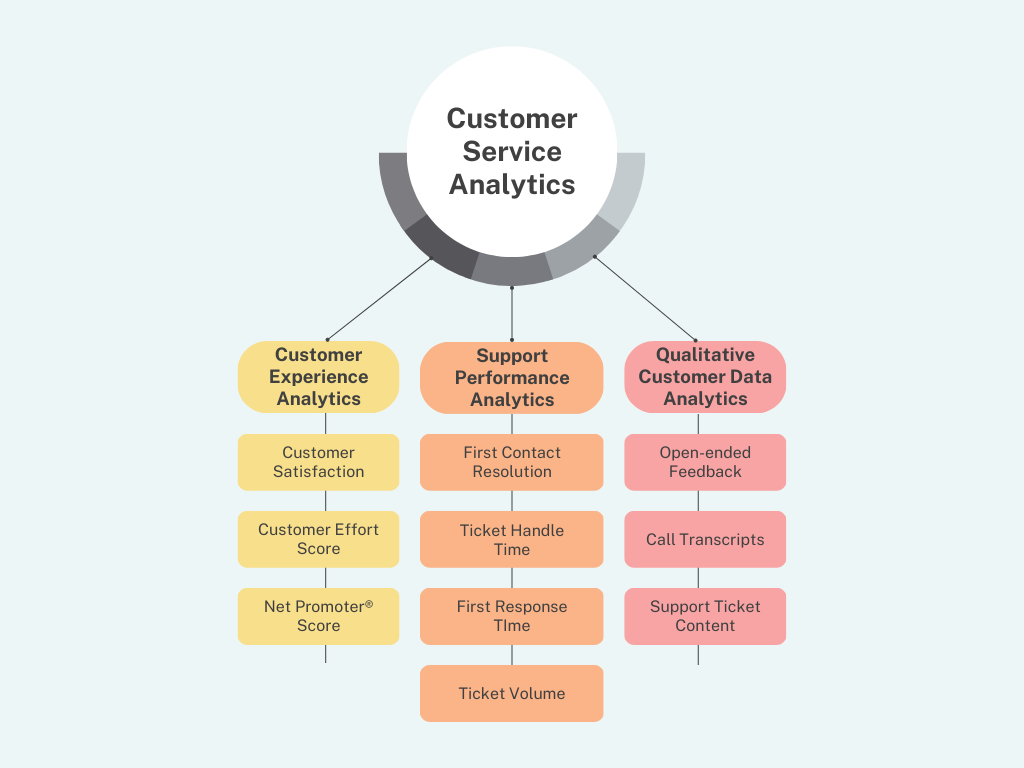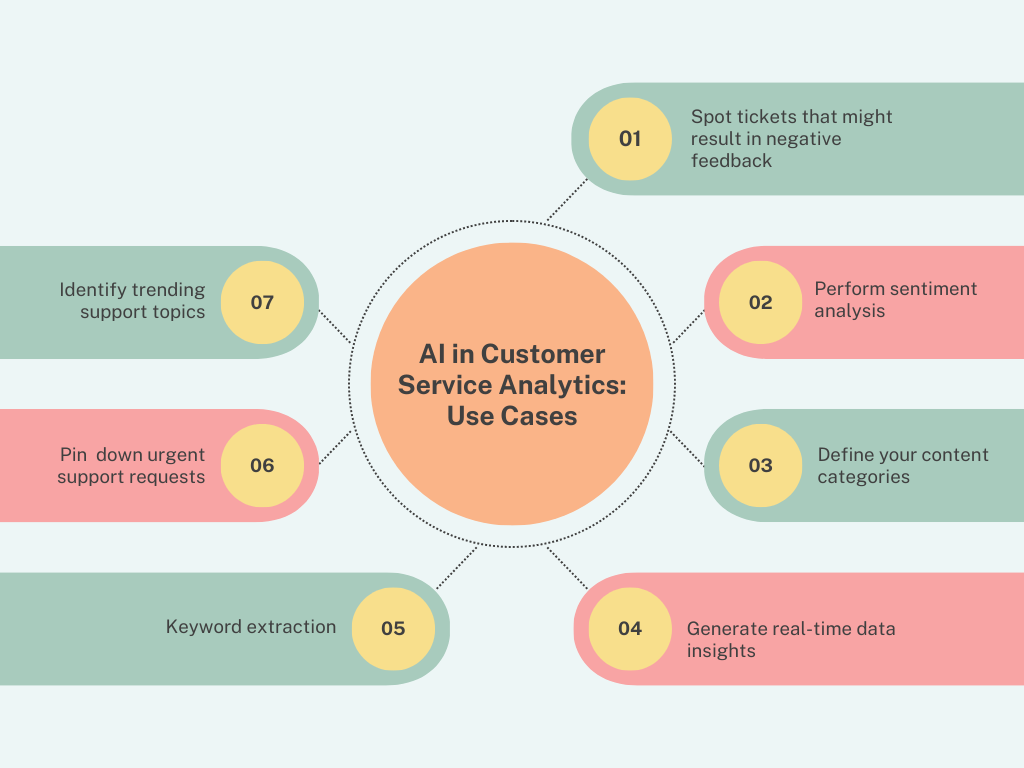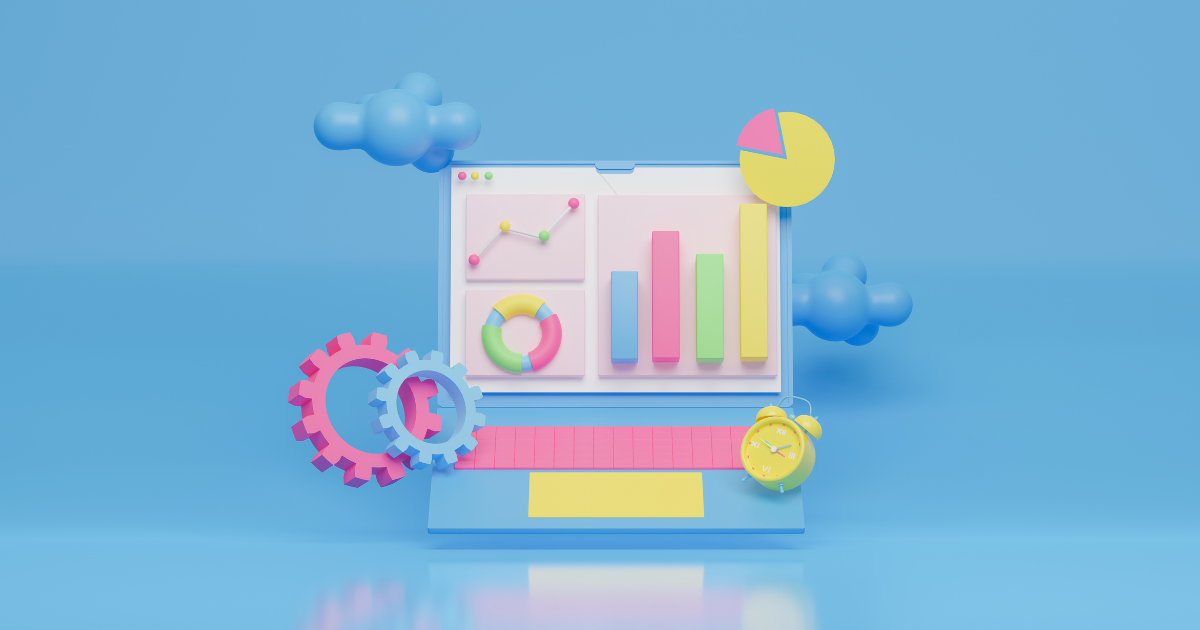Every day we generate 2.5 quintillion bytes of data, as recorded in 2020. Businesses use social media, algorithms, and other tools to organize their data and use it to achieve their goals. Customer service analytics help them to identify the patterns and understand consumer behavior, increase customer loyalty, and improve customer experience.
Seventy-six percent of business leaders, according to a Forbes Insights Survey, think a company’s ability to satisfy its customers is essential to survival. Measurement is the first step in strategizing and improving CX. Your brand may enhance customer experience and forge enduring relationships by measuring and analyzing clients’ data wisely.
With that, let’s dig a bit deeper into the world of customer service analytics:
What is Customer Service Analytics?
Customer service analytics (CSA) is the process of gathering and analyzing data from customer interactions to derive actionable insights. Those insights can be used to determine trends, understand clients’ behavior and needs, improve the customer experience and enhance business processes and strategies.
Customer insight can be found in great depth during support conversations. Any customer care team aiming to evaluate customer sentiment and promote CX improvements should focus on extracting insights from them. Support discussions are distinctive, frequent, and typically held when an issue arises, and the consumer contacts you, and they naturally avoid the complexities and biases found in surveys.
Support teams trying to scale effectively should also consider customer service analysis. For example, automating time-consuming processes like routing, agent feedback, and prioritization depends heavily on accurate data points.
Also, CSA has broader commercial ramifications. We observe that strategically dispersed support insights are incredibly beneficial across the organization, whether for operational optimization and improvement in support or, for example, offering marketing campaign ideas.
Customer Service Analytics Use Cases
Numerous use cases for support conversation analysis go beyond just you and your team. These perceptions can help with customer experience research, CX enhancements, and time-saving procedures for the entire business.
Here are some examples of the most common use cases of customer service analytics:
1. Identify Customer Pain Points
A specific issue that potential clients of your company are facing is known as a pain point. In other words, you might consider troubles, pure and simple, as pain points.
The range and variety of client pain issues mirror that of your potential customers. It might be challenging to advertise to potential customers unaware of their pain points since you must effectively make them aware of their issue and persuade them with your product and services. Additionally, your ability to effectively identify pain points will enable you to take corrective action to not only solve customer problems before they escalate or even happen.
2. Boost Support Performance
Big data enables you to gather information, identify patterns that might be impossible to comprehend, and take immediate action to produce dependable, outstanding experiences that entice customers to return time and time again .
Analytics can help you understand the level of service in your contact center and point you towards the right direction in terms of improving productivity and efficiency.
3. Measure Agent Performance
Everyone in the department, whether they have years of experience like your service manager or are brand-new interns, should be driven to succeed.
You can monitor key performance indicators (KPIs) and compare agent performance to service level agreements (SLAs) using customer service analytics. For instance, you can monitor your agents’ average response times to determine which ones perform above expectations and which need to receive additional training to improve their game.
4. Reduce Customer Service Costs
Data-driven decisions are crucial in providing customer service. Customer service analytics may show you a reflection of the future in addition to past performance.
For instance, your company can determine the customer contact methods that are most popular with clients and accurately allocate resources to the appropriate communication channels. This approach will end up saving you costs because you are able to optimise resource allocation and maximise agent utilization.
5. Anticipate Customer Needs
Brands must comprehend how consumers want to shop, their preferences, and, most importantly, how to pinpoint their points of success. Every day, your consumers share input with you through social media posts, digital interviews, feedback, and contact center calls (to name a few). By taking a closer look at these interactions you will gain the ability to predict future customer behaviour to retain your client base, identify cross- and upsell opportunities, or offer proactive support.
6. Integrate Customer Feedback Into Products & Services
Actively listening to your consumers across the entire customer journey is one of the secrets to success.
You can maintain seeking input while you create your product, particularly if your buyer disapproves of a particular element of your design. You can find out whether they have advised anything you could do differently. You’ll discover that feedback aids in decision-making about your company while maintaining its viability.
You can trust your course of action when you receive feedback. Giving your consumers precisely what they have requested will allow you to advance your business correctly rather than pondering what you believe or wish they want.
7. Improve Customer Retention and Loyalty
Understanding why customers depart is crucial since acquiring new customers is expensive. If you don’t take immediate corrective action, existing customers may leave, and customer data can help you spot commonalities among lost customers and provide an early warning to boost customer retention.
Types of Customer Service Analytics
There are numerous approaches to conducting customer analytics, each with pros and cons. Which one ought you use, then? We’ve listed the main categories of customer service analytics here for your consideration.

Customer Experience Analytics
Data analytics in customer service is all about gathering and evaluating data, typically from various touchpoints. These can include in-person interactions with customers on social media, client website comments, and contact or call center interactions.
The most excellent way to comprehend your present consumers, attract new clients, and foster loyalty is to establish a culture and organizational structure that prioritizes your company’s customer experience (CX). Customers’ engagement, purchase, and LTV directly correlate with CX. You can generate actionable, quantifiable, and profitable insights using customer experience analytics.
These are the most common KPIs from which CX analytics derives its data:
Customer Satisfaction
Customer satisfaction measurement assists businesses by lowering churn, building a solid brand image, saving time and money on customer service, and fostering audience loyalty.
An excellent technique to gauge consumer happiness is to conduct surveys. It’s not quite that simple, however. The secret to gauging it is to ask your customers the correct questions. You could not see the correct data in the responses if you didn’t ask the relevant questions. Without the proper data, you won’t be able to spot problem areas and fix them.
Net Promoter® Score
A widespread customer satisfaction statistic that measures client brand loyalty is called Net Promoter Score (NPS). It tells you whether clients are likely to refer you to others.
- Consumers who rate products 9 to 10 are referred to as promoters. They strongly support the business and would advocate for it to others.
- Consumers that rate 7 to 8 are referred to be passives. They aren’t always committed to the brand and might switch if provided a better option.
- Detractors are customers who offer ratings of 0–6. They are not loyal to the business and could even disparage it.
Customer Effort Score
Some goods or services could be challenging to use and demand much work from the consumer. The Consumer Effort Score (CES) measures how simple using your goods or services is. CES surveys aim to make people work less and be more loyal. There may be additional questions depending on your expected accomplishment with the study.
Loyalty reduces when you have to make additional efforts to encourage potential customers to use your products or services. Making usage as simple as feasible is the goal. Let’s use a retail apparel business as an example. It isn’t delightful for your CES if they must frequently seek employee support, and they might stop shopping at your store altogether. It would be beneficial to pay close attention to customers, offer proactive assistance, and foresee their needs and demands.
Support Performance Analytics
A single system of record for data collection and analysis is performance analytics. Instead of reporting on a specific point in time, use performance analytics to measure, aggregate, and visualize essential performance indicators over time.
Performance metrics are essential for monitoring how well people do their jobs, and the productivity of customer service. Support performance analytics analyse the data from the following metrics:
First Contact Resolution
FCR, or First Contact Resolution, is a crucial customer service metric that measures how well your representatives can handle client issues at first contact. Tracking, measuring, and analyzing your FCR is crucial because of its correlation with customer satisfaction.
Ticket Average Handle Time
Understanding how much time it takes your team on average to resolve a ticket is crucial for several reasons:
- Customer satisfaction: Customers expect their inquiries or issues to be resolved promptly. If the average ticket handle time is too long, customers may become frustrated and dissatisfied with the service, leading to a negative experience.
- Efficiency: A high average ticket handle time can indicate inefficiencies in the customer service process. By analyzing this metric, companies can identify bottlenecks and areas that require improvement to streamline the service process.
- Resource allocation: By analyzing average ticket handle time, companies can determine the number of customer service representatives required to handle a certain volume of inquiries or issues. This helps in allocating resources efficiently, preventing overstaffing or understaffing, which can lead to higher costs or decreased customer satisfaction.
- Cost savings: By optimizing the customer service process, companies can reduce the average ticket handle time, resulting in cost savings. This can be achieved by identifying and addressing issues that cause delays in the service process.
First Response Time
First Response Time gauges how quickly, on average, customer service representatives respond to issues raised by business clients. It can take a few minutes, several hours, or even several business days!
Different FRT expectations apply to customer support channels, such as voice calls, inbound emails, live chats, and SMS.
However, a high FRT means that clients are unaware of your progress on their case regardless of the channel or method of reporting.
Ticket Volume
You can make crucial choices if you know the total number of tickets (requests or problems) received by your company and their nature. For instance, you may determine how many employees you’d need to manage an increase in the number of tickets, and you can design suitable work schedules to ensure your agents are always ready.
Qualitative Support Data Analytics
Qualitative data is more in-depth and unstructured than quantitative data, which records structured information. It can provide us with the answers we seek, aid in creating theories, and advance knowledge.
Customer feedback analysis and qualitative data analysis are most comparable. Paying attention to consumer data can immediately improve a company in the B2B market. Compared to B2C consumer feedback, this is more in-depth and targeted. As a result, the study of consumer feedback is more focused on improving functional areas of the business.
Open-Ended Feedback
Instead of providing a predetermined solution to a Yes/No question or multiple-choice, open-ended questions allow responders to write an answer on their terms. It enables them to express their opinions on the company through narratives, words, or tips.
Brands can discover crucial information beyond a predetermined set of replies and gain insight into their customers’ perspectives using Open-Ended Questions and detailed answers.
Customer Support Ticket Content
Support software has made the phrase “support ticket,” which refers to communication between the support team and customers, widely used. Customers open support tickets when they run into issues; answering support tickets is how customer service personnel communicate with clients. The ticket is closed once the problem has been rectified.
The concept makes sense when discussing how support software functions. Every request receives a unique ticket with a unique ticket number, and this separates consumer requests so that nothing is missed and makes looking up and locating particular encounters simple.
Call Transcripts
A verbal conversation is converted into written text by a process called call transcription, also referred to as speech-to-text transcription. Call transcripts can be created while you’re on the line, or you can record and transcribe calls afterward. You can use voicemail transcripts and call transcription to transform voicemail recordings into text.
Phone call transcriptions are company documents that, like call recordings, can be used to enhance customer service and remove obstacles in the buying process.
Phone recordings are frequently utilized in onboarding and training processes. You essentially get scripts of actual calls that demonstrate methods that work—or don’t—when audio recordings are transcribed. Hence, to better equip your salespeople, include these call transcripts in your sales training, enablement, and onboarding decks.
Predictive Customer Journey Analytics
Consumer expectations continue to alter every year. It’s impossible to accurately see how your customers change without customer journey analytics. It would then be challenging to modify your business strategy to suit their wants better.
According to authoritative studies, employing data from social media platforms to comprehend clients’ journeys is the most straightforward technique to spot behavior changes and record significant insights. Using this analytical method, brands can modify product features, marketing combinations, and communication tactics. Then you can meet clients where they are and go above and beyond what they anticipate.
You can examine each stage of the client experience using software for advanced predictive and data analytics in customer service, providing information about possible future occurrences. You can give your customer loyalty team more authority if you have this insight into customers’ potential future behavior. They can create reward programs that increase the lifetime value of your clients if you provide them with that information. To assist proactive initiatives to reduce churn, you may also provide customer retention teams with advanced intelligence regarding high-flight-risk customers.
Examples of AI in Customer Service Analytics
The growth and development of artificial intelligence (AI) is paving the way for greater efficiency throughout businesses, particularly in customer service.
When it comes to customer service analytics, a variety of AI solutions, such as Natural Language Processing or Machine Learning can help you make sense of your support data from a new perspective.
Here is a list of the most common ways AI can enhance customer service analytics:

1. Identify Trending Topics from Your Support Tickets
Using natural language processing (NLP) and machine learning algorithms AI can identify trending topics in customer service tickets.
Firstly, NLP is used to analyze the text data in support tickets, which includes analyzing the language, structure, and context of the customer’s query. This process can identify patterns and common themes in the data, such as phrases and topics.
Next, machine learning algorithms can be used to categorize the tickets based on these common themes, and group them together based on similarity. The algorithms can then analyze the frequency of these groups over time, allowing them to identify which topics are becoming more common and which ones are decreasing in frequency.
Once the AI has identified trending topics, it can provide insights and recommendations to customer service teams on how to address these topics. For example, the AI might suggest creating a new FAQ section or knowledge base article on a particular topic, or recommend training customer service representatives to handle that topic more effectively.
2. Pin Down Urgent Support Requests
Your help desk needs to process and categorize each issue or support ticket that comes in so that it may be sent to the appropriate team member. Either manually, which entails reading the ticket and assigning a tag by hand, or automatically, which entails putting up rule-based systems, which frequently adhere to the principle of “IF X happens, THEN do Y.”
Since sophisticated AI systems can learn, adapt, and decide what to do without human input, ticket classification using machine learning overcomes the problem of manual ticket classification. Automatic ticket system uses natural language processing and machine learning to process, understand, and synthesize human language quickly, reliably, and economically instead of relying on humans to interpret and categorize the content.
3. Spot Tickets that Might Result in Negative Feedback and Prioritize Them
The act of identifying emotions conveyed in words using artificial intelligence, and its subcategories are known as sentiment analysis (or opinion mining). It uses a predetermined measure to judge if a passage of text sounds good, neutral, or negative.
Millions of comments made on review websites, social media, and online surveys can be analyzed by AI. Even videos can be used for data collection. Sentiment research allows businesses to identify unfavorable views towards their goods, empowering them to act and address such problems in real-time.
4. Perform Sentiment Analysis in Support Interactions
For a good reason, customer sentiment analytics is a hot issue in the CX industry. Bain & company recently stated, “sentiment analysis is a strong approach to keep a touch on customers and even the larger population to understand evolving demands and worries, and new moments of truth.”
It is the right time to use customer sentiment analysis, with over 60% of customers indicating that “they now have higher standards of service requirements.”
Consumer sentiment analysis is the automated method of learning and gauging what consumers think of your product, service, or brand.
Modern support teams probably have a sizable quantity of consumer data. Your representatives communicate with consumers frequently through various touchpoints—from chat and video conversations to emails—leaving the customer’s voice in the discussion or transcripts, which are rich in valuable details about your audience’s preferences.
Companies can access this data using consumer sentiment analysis, which offers profound insights into the thoughts of their clients.
5. Extract Relevant Keywords
A text analysis approach called keyword extraction ( or keyword detection), extracts keywords from the text. It is typically used to condense large amounts of data into crucial talking topics.
Keyword extraction uses machine learning and natural language processing (NLP) to decipher textual material and make it machine-readable. Using unstructured data, such as reports, documents, social media posts, online comments, and news, you can utilize it to extract key terms.
Use cases for keyword extraction typically involve analyzing customer feedback. Brands and organizations must sort out thousands of evaluations to ascertain what consumers like and dislike. You may use keyword extraction to help you analyze customer reviews and pull out keywords from phrases. As a result, you’ll have access to information like consumer feedback or brand perception.
6. Generate Real-Time Customer Support Insights
It’s simple to understand why quantitative surveys gained popularity: they provide a means of obtaining client feedback. Focus groups and manual reading and analysis of client feedback were examples of qualitative methods that were too labor-intensive to scale. Now that technology has altered what is possible, strategies must keep up.
The first and most crucial adjustment businesses should make to refocus their efforts on customer sentiment analysis. Customers’ specialized vocabulary can be captured by AI algorithms, which can then integrate their opinions expressed in simple words with conventional rating systems to produce insightful data. These insights can directly influence short- and long-term activities to retain customers.
An AI-driven approach enables businesses to monitor customer experience in real time and produce insights that enable service providers to deliver a seamless customer intervention and experience as needed for efficient service recovery.
Wrapping Up
Customers are vital to every business’s success and sustainability, and it is crucial to understand their requirements, preferences, and dislikes to attract, keep, and build a client base.
Today’s business executives must be able to think critically and strategically to succeed in their positions. Customer service analytics can question conventional thinking and serve as a significant catalyst for innovation and the creation of customer strategies.
Senior leaders must develop an organizational mindset valuing customer intelligence and encouraging staff to act on all pertinent information for this to occur, though. Instigating transformation that enables brands across industries to move to the rhythm of the consumer trends at the core of their business, complete adoption of customer analytics propels wiser decisions.
Did you like the post?
You might also like:

Surveypal
Everything you need to lead and improve your customer experience. Learn more at surveypal.com, or







